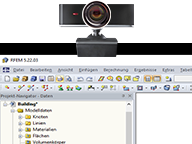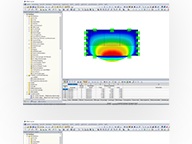Plastic Design of Cross-Sections
RF-/STEEL Plasticity | Features
- Full integration in the RF-/STEEL EC3 add‑on module
- Design of cross-sections for tension, compression, bending, torsion, shear, and combined internal forces
- Plastic design of members according to the second‑order analysis with 7 degrees of freedom, including warping torsion (requires module extension RF‑/STEEL Warping Torsion).
RF-/STEEL Plasticity | Input
The RF-/STEEL Plasticity module extension is fully integrated in RF‑/STEEL EC3. You can enter the data in the same way as in the case of usual design in RF‑/STEEL EC3. However, it is necessary to activate the plastic design of cross-sections in detail settings (see the figure).
RF-/STEEL Plasticity | Design and Results
The cross-section resistance design considers all internal force combinations.
If cross-sections are designed according to the PIF method, the internal forces of the cross-section, which are acting in the system of the principal axes related to the centroid or the shear center, are transformed into a local system of coordinates that rests in the web center and is oriented in the web direction.
The individual internal forces are distributed on the top and bottom flanges as well as on the web, and the limit internal forces of the cross‑section parts are determined. Provided that the shear stresses and the flange moments can be absorbed, the axial load-bearing capacity and the ultimate load capacity for bending of the cross‑section are determined by means of the remaining internal forces and compared to the existing force and moment. If the shear stress or the flange resistance is exceeded, the design cannot be performed.
The Simplex Method determines the plastic enlargement factor with the given internal force combination using the SHAPE‑THIN calculation. The reciprocal value of the enlargement factor represents the design ratio of the cross‑section.
Elliptical cross-sections are analyzed for their plastic load‑bearing capacity on the basis of an analytical nonlinear optimization procedure. This method is similar to the Simplex Method. Separate design cases enable flexible analysis of selected members, sets of members, and actions, as well as of individual cross‑sections.
You can adjust design-relevant parameters such as the calculation of all cross‑sections according to the Simplex Method.
The results of the plastic design are displayed in RF‑/STEEL EC3 as usual. The respective result tables include internal forces, cross‑section classes, overall design, and other result data.
Webshop
Customize your individual program package and find out all the prices online!
Calculate Your Price

The price is valid for United States.








.png?mw=192&hash=f63e4a3f1836233005de32f60201d5392e507cf1)



